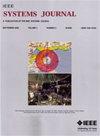DT-LSMAS: Digital Twin-Assisted Large-Scale Multiagent System for Healthcare Workflows
IF 4
3区 计算机科学
Q1 COMPUTER SCIENCE, INFORMATION SYSTEMS
引用次数: 0
Abstract
Digital healthcare has garnered much attention from academia and industry for health and well-being. Many digital healthcare architectures based on large-scale edge and cloud multiagent systems (LSMASs) have recently been presented. The LSMAS allows agents from different institutions to work together to achieve healthcare processing goals for users. This article presents a digital twin large-scale multiagent strategy (DT-LSMAS) comprising mobile, edge, and cloud agents. The DT-LSMAS comprised different schemes for healthcare workflows, such as added healthcare workflows, application partitioning, and scheduling. We consider healthcare workflows with different biosensor data such as heartbeat, blood pressure, glucose monitoring, and other healthcare tasks. We partitioned workflows into mobile, edge, and cloud agents to meet the deadline, total time, and security of workflows in large-scale edge and cloud nodes. To handle the large-scale resource for real-time sensor data, we suggested digital twin-enabled edge nodes, where delay-sensitive workflow tasks are scheduled and executed under their quality of service requirements. Simulation results show that the DT-LSMAS outperformed in terms of total time by 50%, minimizing the risk of resource leakage and deadline missing during scheduling on heterogeneous nodes. In conclusion, the DT-LSMAS obtained optimal results for workflow applications.DT-LSMAS:用于医疗保健工作流程的数字双胞胎辅助大规模多代理系统
数字医疗已经引起了学术界和工业界对健康和福祉的广泛关注。最近出现了许多基于大规模边缘和云多代理系统(LSMASs)的数字医疗体系结构。LSMAS允许来自不同机构的代理一起工作,以实现用户的医疗保健处理目标。本文介绍了一个数字孪生大规模多代理策略(DT-LSMAS),包括移动、边缘和云代理。DT-LSMAS包含用于医疗保健工作流的不同方案,例如添加的医疗保健工作流、应用程序分区和调度。我们考虑使用不同生物传感器数据(如心跳、血压、血糖监测和其他医疗保健任务)的医疗保健工作流。我们将工作流划分为移动、边缘和云代理,以满足大规模边缘和云节点中工作流的截止日期、总时间和安全性。为了处理实时传感器数据的大规模资源,我们建议启用数字双边缘节点,其中延迟敏感的工作流任务在其服务质量要求下进行调度和执行。仿真结果表明,在异构节点调度过程中,DT-LSMAS在总时间上优于50%,最大限度地降低了资源泄漏和截止日期丢失的风险。总之,DT-LSMAS在工作流应用中获得了最佳结果。
本文章由计算机程序翻译,如有差异,请以英文原文为准。
求助全文
约1分钟内获得全文
求助全文
来源期刊

IEEE Systems Journal
工程技术-电信学
CiteScore
9.80
自引率
6.80%
发文量
572
审稿时长
4.9 months
期刊介绍:
This publication provides a systems-level, focused forum for application-oriented manuscripts that address complex systems and system-of-systems of national and global significance. It intends to encourage and facilitate cooperation and interaction among IEEE Societies with systems-level and systems engineering interest, and to attract non-IEEE contributors and readers from around the globe. Our IEEE Systems Council job is to address issues in new ways that are not solvable in the domains of the existing IEEE or other societies or global organizations. These problems do not fit within traditional hierarchical boundaries. For example, disaster response such as that triggered by Hurricane Katrina, tsunamis, or current volcanic eruptions is not solvable by pure engineering solutions. We need to think about changing and enlarging the paradigm to include systems issues.
 求助内容:
求助内容: 应助结果提醒方式:
应助结果提醒方式:


